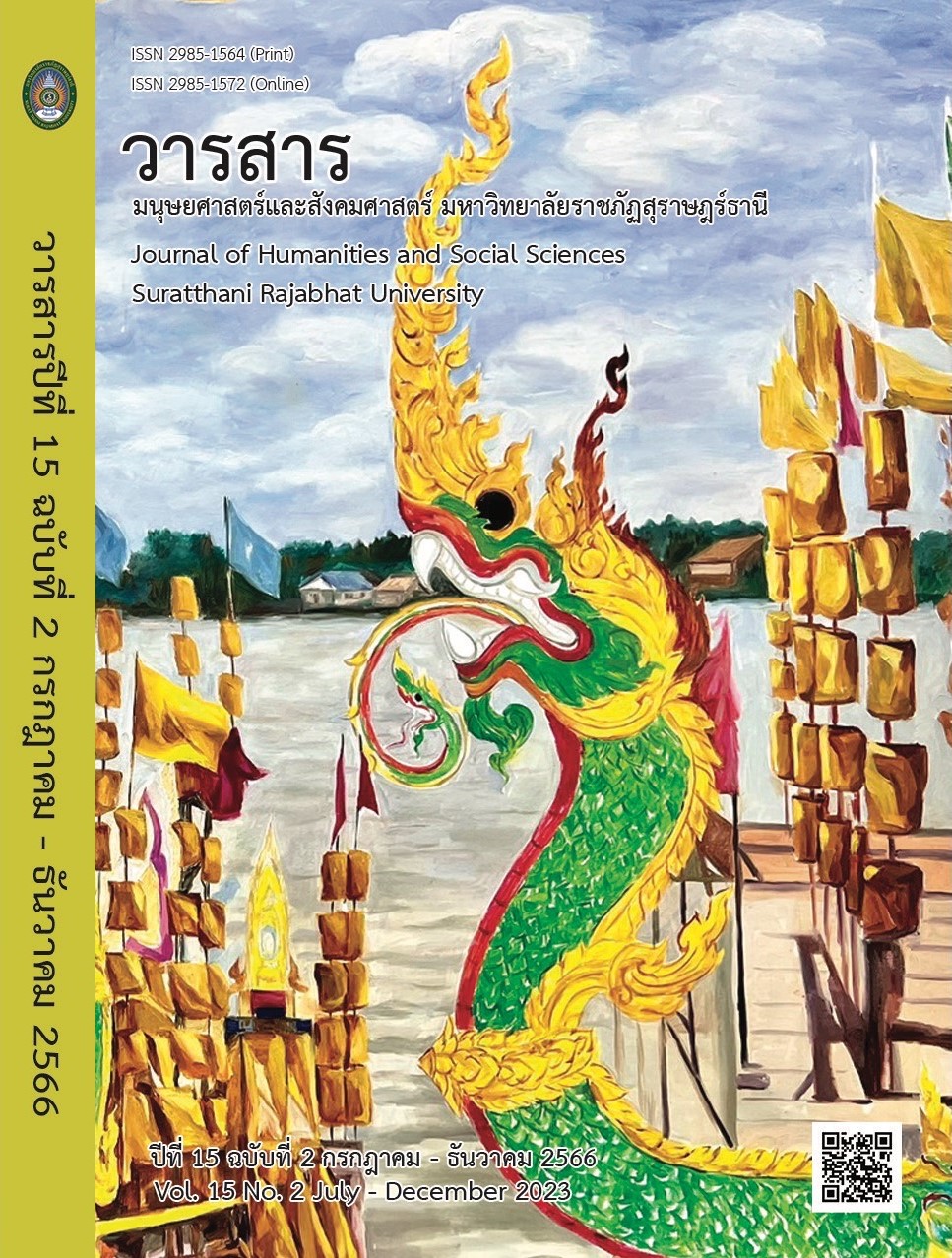The Three Wishes and the Model of Buddhadhamma Interpretation in Buddhadasa Bhikkhu
Main Article Content
Abstract
The purposes of this study were 1) to examine the three wishes of the Buddhadasa Bhikkhu, 2) to explore the principles of philosophy and
religious interpretation, and 3) To analyze the construction of the Buddhist
interpretation grounded model in Buddhadasa Bhikkhu's three wishes
employing qualitative research. This study gathers data through both
primary and secondary surveys of relevant documents and literature and analyzes the information using descriptive and analytical approaches.
The findings reveal that 1) Buddhadasa Bhikkhu's three wishes
encompass (1) striving to grasp the essence of one's religion, (2) seeking
mutual understanding among different religions, and (3) endeavoring to guide the world away from materialism. These aspirations highlight the
significance of the Theory of Human Language, Dharma Language, as a
pivotal interpretative tool. Furthermore, the central Buddhist teachings
identify the principles of interpretation as follows: (1) the categorization of sutras or passages, (2) the concept of celibacy, (3) metaphorical teachings, (4) the use of two kinds of language, and (5) the Buddha's methods of
answering questions. These principles have evolved from the Buddha's time to the present day. Lastly, the study delineates a model for interpreting the Buddhadharma based on Buddhadasa Bhikkhu's three wishes, which include interpretation for (1) self-understanding, (2) understanding others, and
(3) world understanding. This model proposes an alternative approach to understanding Buddhadharma, fostering self-awareness, reducing conflicts, promoting inter-religious reconciliation, and addressing environmental
degradation and global materialism issues.
Article Details

This work is licensed under a Creative Commons Attribution-NonCommercial-NoDerivatives 4.0 International License.
All published manuscripts have been verified by peer-peer professors in the fields of humanities and social sciences. Reprinting of the article must be authorized by the editorial staff.
References
กรมการศาสนา. (2525). พระไตรปิฎกภาษาไทย ฉบับหลวง (พิมพ์ครั้งที่ 4). เล่มที่ 10.
กรุงเทพฯ: กระทรวงศึกษาธิการ.
กรมการศาสนา. (2525). พระไตรปิฎกภาษาไทย ฉบับหลวง (พิมพ์ครั้งที่ 4). เล่มที่ 11.
กรุงเทพฯ: กระทรวงศึกษาธิการ.
กรมการศาสนา. (2525). พระไตรปิฎกภาษาไทย ฉบับหลวง (พิมพ์ครั้งที่ 4). เล่มที่ 12.
กรุงเทพฯ: กระทรวงศึกษาธิการ.
กรมการศาสนา. (2525). พระไตรปิฎกภาษาไทย ฉบับหลวง (พิมพ์ครั้งที่ 4). เล่มที่ 14.
กรุงเทพฯ: กระทรวงศึกษาธิการ.
กรมการศาสนา. (2525). พระไตรปิฎกภาษาไทย ฉบับหลวง (พิมพ์ครั้งที่ 4). เล่มที่ 16.
กรุงเทพฯ: กระทรวงศึกษาธิการ.
กรมการศาสนา. (2525). พระไตรปิฎกภาษาไทย ฉบับหลวง (พิมพ์ครั้งที่ 4). เล่มที่ 17.
กรุงเทพฯ: กระทรวงศึกษาธิการ.
กรมการศาสนา. (2525). พระไตรปิฎกภาษาไทย ฉบับหลวง (พิมพ์ครั้งที่ 4). เล่มที่ 19.
กรุงเทพฯ: กระทรวงศึกษาธิการ.
กรมการศาสนา. (2525). พระไตรปิฎกภาษาไทย ฉบับหลวง (พิมพ์ครั้งที่ 4). เล่มที่ 20.
กรุงเทพฯ: กระทรวงศึกษาธิการ.
กรมการศาสนา. (2525). พระไตรปิฎกภาษาไทย ฉบับหลวง (พิมพ์ครั้งที่ 4). เล่มที่ 21.
กรุงเทพฯ: กระทรวงศึกษาธิการ.
กรมการศาสนา. (2525). พระไตรปิฎกภาษาไทย ฉบับหลวง (พิมพ์ครั้งที่ 4). เล่มที่ 24.
กรุงเทพฯ: กระทรวงศึกษาธิการ.
กรมการศาสนา. (2525). พระไตรปิฎกภาษาไทย ฉบับหลวง (พิมพ์ครั้งที่ 4). เล่มที่ 25.
กรุงเทพฯ: กระทรวงศึกษาธิการ.
ประเวศ อินทองปาน. (2553). พุทธปรัชญาในพระไตรปิฎก (พิมพ์ครั้งที่ 3). กรุงเทพฯ:
สำนักส่งเสริมและฝึกอบรม มหาวิทยาลัยเกษตรศาสตร์.
ปรีชา ช้างขวัญยืน, และ สมภาร พรมทา. (2552). มนุษย์กับศาสนา (พิมพ์ครั้งที่ 4).
กรุงเทพฯ: โรงพิมพ์แห่งจุฬาลงกรณ์มหาวิทยาลัย.
ปรุตม์ บุญศรีตัน. (2550). รูปแบบการตีความคัมภีร์ในพระพุทธศาสนาเถรวาท.
วิทยานิพนธ์ พธ.ด. (พระพุทธศาสนา). กรุงเทพฯ: มหาวิทยาลัยมหาจุฬาลงกรณ
ราชวิทยาลัย.
พนารัตน์ จันทร์สิทธิเวช. (2558). การศึกษาวิเคราะห์การตีความหลักพุทธธรรมของเชอ
เกียม ตรุงปะ. วิทยานิพนธ์ พธ.ด. (พระพุทธศาสนา). กรุงเทพฯ: มหาวิทยาลัย
มหาจุฬาลงกรณราชวิทยาลัย.
พระพรหมคุณาภรณ์ (ป.อ.ปยุตฺโต). (2549). พุทธธรรม (พิมพ์ครั้งที่ 11). กรุงเทพฯ:
โรงพิมพ์สหธรรมิก.
พุทธทาสภิกขุ. (2516). อิทัปปัจจยตา. สุราษฎร์ธานี: ธรรมทานมูลนิธิ.
พุทธทาสภิกขุ. (2537). ภาษาคน-ภาษาธรรม. กรุงเทพฯ: ธรรมสภา.
พุทธทาสภิกขุ. (2541). มรดกที่ขอฝากไว้. กรุงเทพฯ: ธรรมทานมูลนิธิ.
พุทธทาสภิกขุ. (2549). ปณิธาน 3 ประการ (พิมพ์ครั้งที่ 2). กรุงเทพฯ: สุขภาพใจ.
วีระ สมบูรณ์. (2549). พุทธทาสยังอยู่ไปไม่ตาย เล่ม 2 สืบสานปณิธานพุทธทาส.
กรุงเทพฯ: คณะอนุกรรมการฝ่ายหนังสืออนุสรณ์ 100 ปี ชาตกาล พุทธทาส
ภิกขุ.
วีรชาติ นิ่มอนงค์. (2552). การศึกษาวิเคราะห์ทฤษฎีอรรถปริวรรตศาสตร์ในพระพุทธ
ศาสนาเถรวาท. กรุงเทพฯ: สถาบันวิจัยพุทธศาสตร์ มหาวิทยาลัยจุฬาลงกรณ
ราชวิทยาลัย.
เสถียร โพธินันทะ. (2516). ชุมนุมพระสูตรมหายาน. กรุงเทพฯ: บรรณาคาร.
เสรี พงศ์พิศ. (2528). ท่านพุทธทาสกับสังคมไทย. กรุงเทพฯ: รุ่งแสงการพิมพ์.
Lopez. D. (1988). Buddhist Hermeneutics. Honolulu: University of Hawaii
Press.


